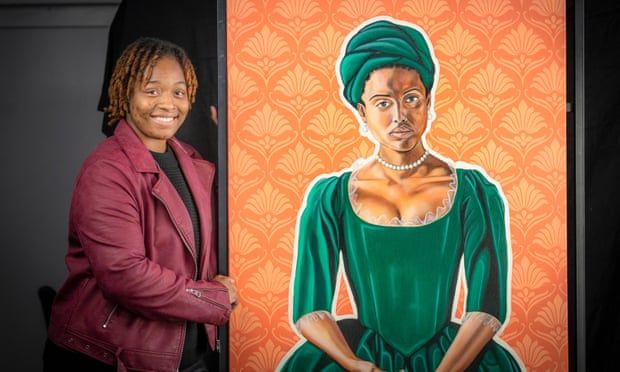English Heritage’s six portraits range from a Roman emperor to Queen Victoria’s goddaughter
Six paintings that tell fascinating, not widely known stories of people from the African diaspora in England’s history, including the Roman emperor who strengthened Hadrian’s Wall and Queen Victoria’s goddaughter, have been unveiled by English Heritage.
The heritage body commissioned six artists to paint portraits, putting them on display at forts, abbeys, historic houses and barracks where they have an association.
The project was about bringing their stories to life for a wider audience, said Anna Eavis, English Heritage’s curatorial director. “African figures from the past have played significant roles at some of the historic sites in our care but many of their stories are not very well known.”
The subjects include Septimius Severus, who was born in Leptis Magna, the present day city of Al-Khums in Libya. He travelled to Britain in AD208 and ordered the strengthening of Hadrian’s Wall and the reoccupation of the Antonine Wall, across what is now central Scotland, with a view to expanding his empire.
He has been painted by Elena Onwochei-Garcia who said she was drawn to Septimius because of her own multiheritage background, in her case Nigerian, Spanish and German. “This made me reflect on how people might imagine someone like us to look like,” she said.
“I wanted to go beyond painting Rome’s ‘African emperor’, to portray a complex individual by paying attention to his personality and how he chose to be seen in his coins, statues and architecture.
“Historically, black people have had little control over their portrayal. Septimius Severus embodied and altered the image of the Roman empire.”
The portrait goes on display from Wednesday at Corbridge Roman Town on Hadrian’s Wall.
 Mikéla Henry-Lowe with her portrait of Dido Belle.
Mikéla Henry-Lowe with her portrait of Dido Belle.
Another subject is Dido Belle, born in 1761, the daughter of an enslaved black woman and a British naval officer. She was raised as part of the aristocratic Murray family in Georgian London and spent much of her life at Kenwood House on the edge of Hampstead Heath.
Belle has been painted by Mikéla Henry-Lowe. She welcomed “the opportunity to paint a black woman who experienced growing up in an aristocratic family, because most depictions of black women in Georgian Britain were shown as slaves.”
Clifton Powell has painted Abbot Hadrian, an African scholar in Anglo-Saxon England and the abbot of St Augustine’s Abbey, Kent. Hadrian was from Cyrenaica, a Roman/Byzantine province in north Africa.
Powell said he had felt his subject’s presence since he started the portrait and played monastic Gregorian chants while he painted.
Hannah Uzor has painted the portrait of Sarah Forbes Bonetta, the daughter of a west African ruler who was enslaved by King Gezo of Dahomey, present-day Benin. In 1850, Bonetta was presented as a “diplomatic gift” to a British naval captain, Frederick Forbes, and taken to England.
Bonetta was introduced to Queen Victoria who was evidently charmed by her, describing her as “sharp and intelligent”. Victoria became her godmother and paid for her education in Sierra Leone and Gillingham, Kent.
Chloe Cox has painted Arthur Roberts, the son of a Trinidadian man, who was born in 1897 in Bristol and grew up in Glasgow. He served in the first world war and survived the battle of Passchendaele. The painting is on display at Berwick-upon-Tweed barracks in Northumberland.
The sixth painting is of James Chappell (1648-1730), a servant at Kirby Hall, Northamptonshire, who saved the life of the hall’s owner. He has been painted by Glory Samjolly.















